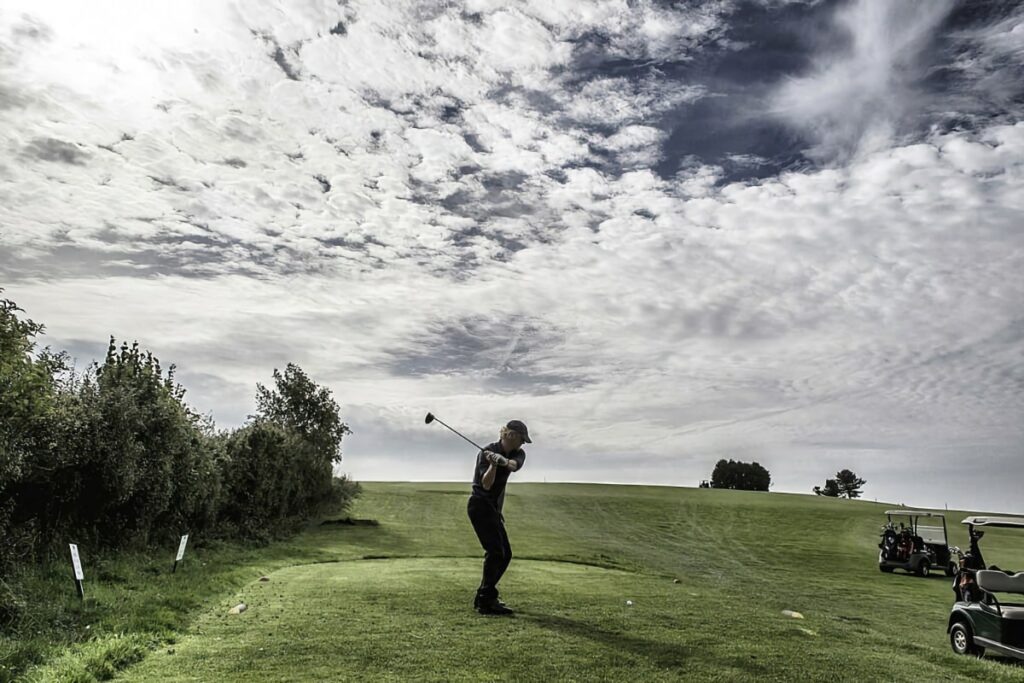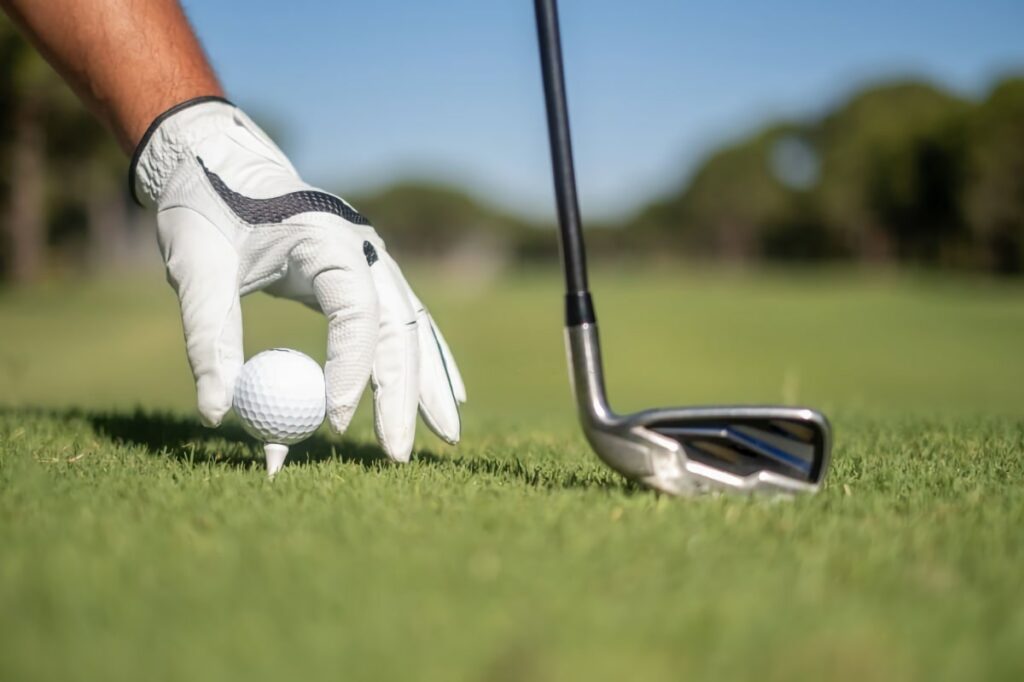Why is driver so hard to hit for many amateur golfers?
With the least loft and greatest margin for error of any club, the driver’s unique properties make it challenging to strike consistently.
Its longer shaft reduces control of the clubface compared to irons. The driver swing also requires hitting up on the ball, unlike irons where you hit down.
But, taking the time to master proper alignment, ball position, and tempo with your driver is well worth the effort for maximizing distance.
Read on to learn how to hit a driver straight. I’ll share actionable tips to tame the beast, so you can start bombing your drives down the fairway!
Why Is Driver So Hard to Hit
Many amateur golfers find driver hard to hit because it’s the least lofted club, and generates the highest ball speed. Therefore, it has the greatest margin for error and is harder to hit straight. Also, it’s the longest club in the bag which makes it harder to control the clubface.

Why Do I Hit Irons Better Than Driver?
It’s surprisingly common for amateur golfers to feel comfortable with hitting their irons, yet struggle to control their driver off the tee.
There are two key differences between drivers and irons:
- The difference in loft
- The difference in length
- The difference in swing
Let’s take a closer look at how these affect the difficulty of each type of club.
1. The Difference in Loft
Firstly, irons have more loft than drivers. As a result, shots will travel a shorter distance and the margin for error is relatively small.
By contrast, the driver is the least lofted club in the bag. This means it generates the most ball speed, which amplifies the effect of mishits.
2. The Difference in Length
The second major difference to consider is shaft length.
Drivers are longer clubs than irons. This means that you have to stand further away from the ball, which makes it more challenging to control the clubhead during the swing.
This can make it difficult to find the center of the clubface, increasing the risk of hooks and slices due to the horizontal gear effect.
3. The Difference in Swing
Finally, there is a difference between the iron swing and the driver swing.
In playing golf, we learn to hit down on the ball with our iron shots, in order to compress the ball and generate spin.
However, with the driver, you need to swing up against the ball to optimize ball speed and minimize unwanted spin. This can be challenging after becoming comfortable with the iron swing and can be a cause for issues when hitting the driver.

Are Driving Irons Easier to Hit Than Drivers?
If your driver is seriously hampering your performance on the course, there is an alternative club that’s designed for tee shots – the driving iron.
What Is a Driving Iron?
A driving iron is a golf club that is designed predominantly for use off the tee.
It’s a long iron equipped with low loft and low spin and is capable of being hit an average of 215 yards off the tee.
While it can be used off the fairway, the driving iron is best used off the tee as an alternative to drivers, fairway woods, or hybrids.
Driving Iron Advantages
A relatively new invention in the golf world, the driving iron has started to gain popularity as golfers seek a reliable club for accurate tee shots.
There are several advantages of using a driving iron rather than a regular driver:
- Low flight: Easier to keep under the wind in tough conditions
- Shorter shaft: Easier to control the clubface than the driver
- Low spin: Generates an average distance of 215 yards
- Chunky head: Provides more forgiveness than long irons
If you tend to hook or slice your driver, a driving iron can be an excellent addition to your golf bag. It provides an option when accuracy is essential, serving as a valuable fairway finder.
Driving Iron Disadvantages
However, there are some disadvantages when compared with a typical driver:
- Less distance: 215 yards on average vs. 230 yards with the driver
- Swing speed: Better suited for players with faster swing speeds
- Low flight: This means more rollout, making it harder to stop
While a driving iron can be useful in some situations, remember that you can only carry a maximum of 14 clubs in your golf bag including your putter.
So, would you replace the driver? If not, it’s worth investing time in learning how to hit your driver consistently, for more reliability off the tee.
Read on to learn how to master your driver, turning it into the ultimate fairway finder!

How to Hit Driver Consistently
While driving irons can be a good alternative if you’re really struggling with the driver, nothing beats the distance achieved with a solid drive.
To hit the driver consistently, there are three elements to address:
- Alignment: Stand perpendicular to the target
- Ball Position: In line with the inside of your front heel
- Impact: Swing smoothly to find the center of the clubface
Firstly, let’s take a look at alignment.
1. Alignment
Many amateur golfers are susceptible to slicing the ball. This is caused by the action of swinging from out to in, cutting across the ball, and adding sidespin.
To compensate, many golfers aim further left rather than solving the flaw. This simply causes the ball to slice more, losing both control and distance.
Correct alignment is essential in the driver swing. Stand so that your feet are perpendicular to the target, with the clubface pointing directly at the target.
By standing square to the target, a straighter ball flight will find the fairway without relying on unpredictable and inconsistent sidespin.
PRO TIP: Use alignment sticks as a visual aid to help understand where to stand in the driver setup.
2. Ball Position
Next, it’s important to think about the ball position in the driver setup.
When hitting driver, the ball should be in line with the inside of your left heel. This enables you to strike up against the ball for the best launch angle.
In addition, tilt your upper body slightly to further exaggerate the motion of striking up against the ball.
PRO TIP: Keep your right elbow tucked close to your ribcage in the driver swing to prevent a slice. To practice this, simply tuck a headcover under your right elbow and avoid dropping it.
3. Impact
So, you’ve lined up to the target and positioned the ball correctly. Now, it’s time to swing and focus on the ball strike.
Swing at around 75% effort to help maintain full control of the driver. This enables you to focus on striking the ball with the center of the clubface.
Keeping the clubface square at impact ensures that there is less vertical or horizontal spin applied to the ball, maximizing ball speed and ultimately distance.
PRO TIP: Position an alignment stick outside the ball and pointed directly at the target. This encourages you to swing from the inside, preventing the slice.
Check out this video by Golf Mates, where PGA Pro Dave MacKinnon demonstrates how to hit the driver consistently longer and straighter:
Conclusion
In summary, the driver can be a difficult club to hit because it’s the longest and least lofted club in the golf bag.
This means it generates the most ball speed, with the greatest margin for error.
To improve your consistency with the driver, focus on three things:
- Alignment: Stand perpendicular to the target
- Ball Position: In line with the inside of your front heel
- Impact: Swing smoothly to find the center of the clubface
By mastering these important components of the driver swing, you’ll improve both distance and accuracy off the tee.


